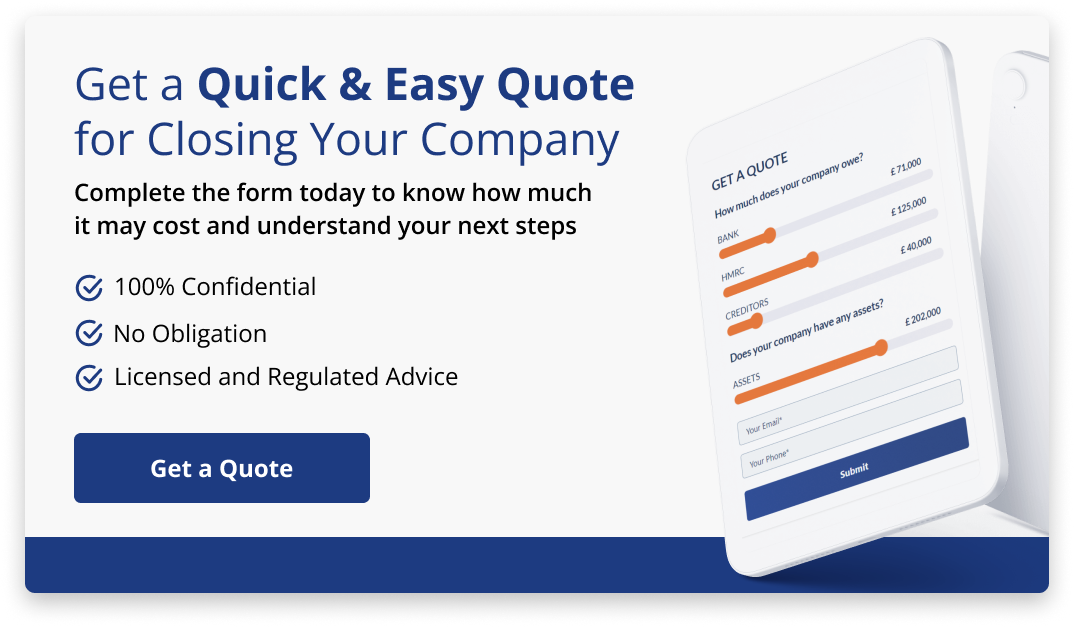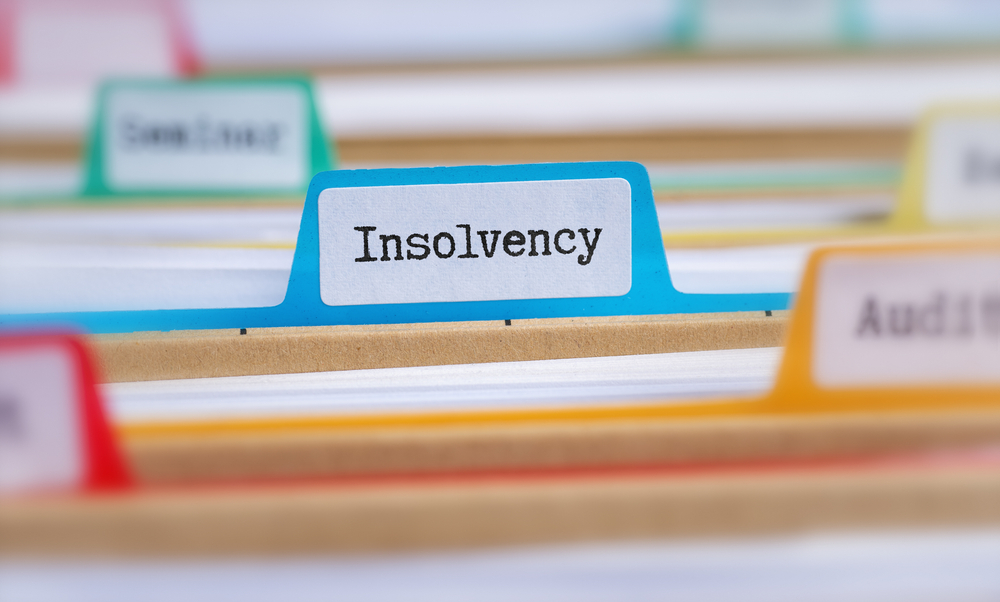
How to Liquidate a Limited Company
Understanding Company Liquidation
Liquidating a company can be a daunting prospect, but understanding the process can make it more manageable.
In essence, Liquidation is the formal process of closing a company by ceasing its operations, selling its assets and distributing the proceeds to claimants.
Once the process is complete, the company is dissolved and removed from the Companies House register.
Liquidation can occur for several reasons, depending on the company’s financial situation, and can be voluntary or compulsory.
There are three primary forms of liquidation:
- Members’ Voluntary Liquidation (MVL) for solvent companies
- Creditors’ Voluntary Liquidation (CVL) for insolvent companies
- Compulsory Liquidation where your company is liquidated by a court order.
Liquidation isn’t always a sign of failure. For some, it’s a strategic exit. For others, it’s the best way to address overwhelming debt. Whatever your situation, it’s crucial to understand the implications for your business and personal finances.
Are you considering liquidation? Let’s discuss your specific circumstances and explore all available options. Our team can guide you through each step, ensuring you make informed decisions about your company’s future.

Is Liquidation the Right Choice for Your Business?
Deciding whether liquidation is the best course of action depends on the financial health of your business.
If your company is solvent (able to pay off its debts), a Members’ Voluntary Liquidation (MVL) is a structured way to close the business and pay off any remaining debts, ensuring all legal and financial obligations are met. After all debts are settled, shareholders may receive money from selling the company’s remaining assets.
On the other hand, if your company is insolvent (unable to pay its debts), a Creditors’ Voluntary Liquidation (CVL) might be the right choice to handle outstanding liabilities in a formal and legally compliant manner.
Key considerations include:
- For solvent companies: Is the business still needed? Are the shareholders ready to wind up operations and distribute remaining assets?
- For insolvent companies: Is the company struggling to meet its financial obligations? Has cash flow become unsustainable, making liquidation a necessary step to protect creditors and limit further liabilities?
Understanding whether your company is solvent or insolvent is the first step to determining the right type of liquidation for you.
How to Liquidate an Insolvent Limited Company
Here’s how you go about liquidating a company that can’t pay its debts:
Recognising Insolvency and Deciding to Liquidate
The process begins when the company’s directors recognise that the business is no longer able to meet its financial obligations. Signs of insolvency include:
- The inability to pay creditors on time
- Running out of cash to cover day-to-day operations
- Having more liabilities than assets
Once insolvency is confirmed, the directors must take immediate steps to avoid further liabilities, including ceasing trading and deciding to liquidate the company through a CVL. Failure to act promptly can lead to allegations of wrongful trading, which could result in personal liability for the directors.
Appointing an Insolvency Practitioner
The directors must then appoint a licensed Insolvency Practitioner (IP) to act as the liquidator. The Insolvency Practitioner’s role is critical in managing the liquidation process and ensuring that the company’s assets are handled in the best interests of the creditors.
The liquidator’s duties include:
- Notifying creditors of the liquidation and the process to follow
- Assessing the company’s assets and liabilities
- Ensuring that the company ceases trading
Directors’ Statement of Affairs
The directors are required to prepare a Statement of Affairs, which is a detailed document outlining the company’s financial position. This statement includes:
- A list of the company’s assets (e.g., property, equipment, cash at bank)
- A breakdown of all liabilities (e.g., unpaid bills, loans, tax obligations)
- A net assessment of the company’s worth
The Statement of Affairs is presented to the creditors and liquidator to provide a clear picture of the company’s financial health at the time of liquidation. It serves as the foundation for managing the sale of assets and repayment of debts.
Calling a Shareholders’ Meeting
A shareholders’ meeting must be convened to approve the liquidation process. At least 75% of the shareholders (by value) must agree to proceed with the CVL. This formal vote authorises the liquidator to take control of the company’s affairs and begin the liquidation.
Once the resolution is passed, the liquidation is officially initiated, and the company ceases to trade. The resolution must be filed with Companies House, and the liquidator is formally appointed.
Creditors’ Meeting
The liquidator will call a creditors’ meeting (often held virtually) within 14 days of the shareholders’ resolution. During this meeting, the creditors:
- Review the Statement of Affairs
- Vote to confirm the appointment of the liquidator or propose an alternative
Creditors may ask questions regarding the company’s financial state and seek to understand how much of their claims will be repaid.
Sale of Assets
The liquidator takes control of the company’s assets and begins the process of selling them to raise funds. Assets such as property, stock, machinery, and other valuable items are sold, and the proceeds are used to pay off the company’s debts.
Priority is given to secured creditors (those with claims backed by company assets), while unsecured creditors (those without security) are paid from the remaining funds. If there is insufficient money to pay all creditors, they may only receive a portion of what they are owed.
Distribution of Proceeds
The liquidator is responsible for distributing the proceeds from the sale of assets to the creditors. The order in which creditors are paid is important:
- Secured creditors (e.g., banks with secured loans) are paid first.
- Preferential creditors, such as employees owed wages, are next.
- Unsecured creditors, including suppliers and trade creditors, are paid last.
In many cases, unsecured creditors may not recover the full amount they are owed, depending on the available funds from the asset sales.
If all debts are paid, any remaining funds are distributed to shareholders. This occurs only if surplus funds remain after all creditors have been paid.
Final Report and Company Dissolution
Once the company’s assets are sold, and the debts are settled to the extent possible, the liquidator prepares a final report for the creditors and shareholders. This report details the liquidation process, the sale of assets, and how the proceeds were distributed.
After submitting the final report to Companies House, the company is formally dissolved and removed from the Companies House register. At this point, the company ceases to exist as a legal entity.

How to Liquidate a Solvent Limited Company
If your company is solvent, the process is similar but with a few key points of divergence, as I’ll explain.
To liquidate a solvent company through a Members’ Voluntary Liquidation (MVL), the directors must first sign a Declaration of Solvency, confirming that the company can pay its debts within 12 months. Following this, the shareholders pass a resolution to wind up the company, and a licensed liquidator is appointed to handle the process.
The liquidator will sell the company’s assets, settle any debts, and distribute the remaining funds to the shareholders.
Once the liquidation is complete, the company is formally dissolved and removed from the Companies House register. The process is straightforward and ensures that all financial obligations are met before the company is closed.
mpanies with few assets and creditors, it could be completed more quickly.
What Happens After Company Liquidation?
- Company Removal: The company is officially removed from the Companies House register and no longer exists as a legal entity.
- No Further Liabilities: Once the company is dissolved, directors, shareholders, and creditors have no further legal or financial obligations related to it.
- Director and Shareholder Impact: Directors typically face no further consequences unless misconduct is identified, and shareholders receive their share of any remaining assets in an MVL.
- Public Record: The liquidation and dissolution are recorded in public records, which may affect the creditworthiness of directors for future ventures.
- Company Restoration: In rare cases, a company can be restored to the register, usually within six years, if there is an error or an unresolved claim.
After liquidation, the company is dissolved, its affairs are closed, and all parties can move forward without further obligations.
How Company Debt Can Help
If you’re contemplating liquidating your limited company, engaging with an insolvency expert is essential. Company Debt boasts a dedicated team of licensed insolvency practitioners, offering nationwide support to businesses in distress.
We’re equipped to help you comprehend the full scope of your options for closing your company, regardless of its financial state, and determine if liquidation is a viable route for you.
FAQs on How to Liquidate a Limited Company
Can a Company Reverse a Liquidation Decision?
Once a company has entered into liquidation, particularly in the case of a Creditors’ Voluntary Liquidation (CVL), reversing the decision is highly unlikely. The company’s assets will have been placed under the control of the liquidator, and the process is designed to resolve outstanding debts. In exceptional cases, if a company can repay all debts and demonstrate solvency before the liquidation is complete, an MVL could potentially be halted. However, this is rare.
How Long Does the Liquidation Process Take?
The duration of voluntary liquidation depends on the complexity of the company’s assets and liabilities.
CVL: For insolvent companies, the process can take longer, especially if the liquidator must deal with multiple creditors, contested claims, or complicated financial issues. The liquidation may take several months or even years if the company’s assets are difficult to realise.
MVL: For solvent companies, the process is typically quicker, often taking between 6 to 12 months, depending on how fast the company’s assets can be sold and debts settled.
What Happens to Directors After Liquidation?
In an MVL, directors generally face no further action once the liquidation is complete, as the company has paid off all its debts. They can continue to run other businesses or start new ventures without restriction.
In a CVL, however, directors’ conduct may be reviewed by the liquidator to ensure there was no wrongful trading before insolvency. If the liquidator finds evidence of misconduct, the directors could face personal liability for some company debts or even disqualification from holding directorships in the future.
Can a Company Trade After Liquidation Begins?
No, once a company enters voluntary liquidation (either MVL or CVL), it must cease trading immediately. The liquidator takes control of the company’s affairs, and continuing to trade would be illegal, particularly in the case of an insolvent company. Any business operations after the liquidation starts could lead to legal consequences for the directors.
What Happens to Employees During Liquidation?
In both MVL and CVL, employees are typically made redundant as part of the liquidation process.
In an MVL, employees should receive any outstanding wages and entitlements since the company is solvent.
In a CVL, employees are considered unsecured creditors and may file claims for unpaid wages, holiday pay, or redundancy through the Redundancy Payments Service if the company’s assets are insufficient to cover these obligations.








